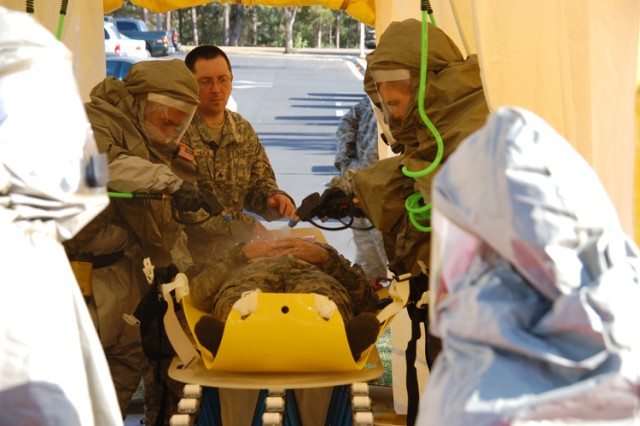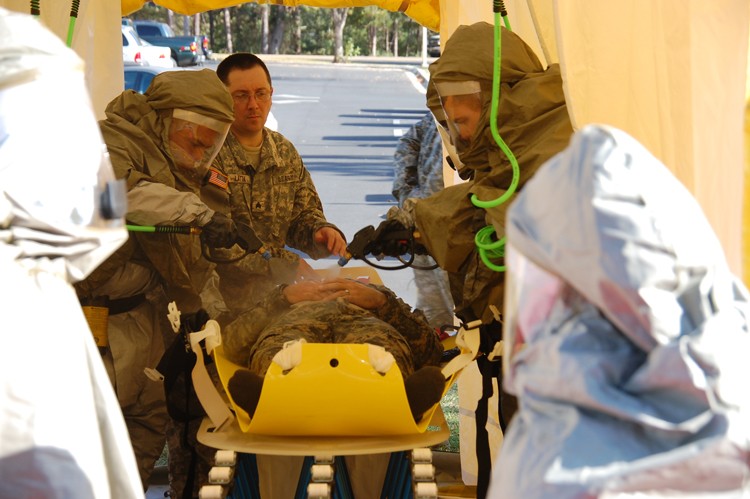When Capt. Jacy Park, commander, 51st Chemical Company, 83rd Chemical Battalion, located at Fort Polk, Louisiana, learned her company would change its primary mission from detection to decontamination, she decided her Soldiers needed a little "interagency" training to prepare for any emergency Fort Polk might face in the event of a chemical accident or attack.
"I began in February coordinating with the Fire Department to train for real-world situations that might involve chemical spills and mass casualty scenarios," Park said.
The result of that early work was an exercise held Nov. 6 that saw the 51st Chem Co, the Directorate of Emergency Services Fire Department, MedExpress Ambulance Service and Bayne-Jones Army Community Hospital work to mitigate an on-post accident involving a blister agent.
Park gave one of her platoon leaders, 1st Lt. Benjamin Fitting, the task of planning the exercise. Fitting developed a scenario in which two vehicles collided on Texas Avenue, causing a blister agent to spill.
As the scenario played out, fire department personnel, under the command of Capt. Devon Fletcher, responded to the accident site - set up in the 51st Chem Co motor pool - and determined there was a possibility of chemical agent involvement.
"We were the first to arrive on the scene," Fletcher said. "We took stock of the situation and determined some type of chemical spill had occurred."
Fletcher asked the 51st Chem Co for their assistance.
"This was a major part of what we wanted to accomplish with the training - interagency communication," said Greg Self, Fort Polk Fire Department's assistant chief for training. "We have different types of radios and sometimes communication between military and civilian agencies can be difficult. Because of this exercise, we are now able to work around those potential problems."
Once the 51st Chem Co decontamination team, led by 1st Lt. Travis Cox, arrived at the accident site, Soldiers, dressed in decontamination suits and armed with devices that detect chemical agents, began checking the area for possible contamination.
"We sent our Soldiers in," Cox said. "After performing first aid on the injured, they began evacuating Soldiers to the on-site decontamination site."
That site, set up by fire department personnel, included a high-intensity shower. Each Soldier or firefighter exposed to the blister agent was required to pass through the shower.
That might seem like a simple task, but Fletcher said one of the lessons learned concerned the shower.
"We determined that the casualties who were on stretchers needed to be rolled to their side under the shower so they could be completely decontaminated," Fletcher said.
"Instead of just telling the decontamination team what they should do, we had them go back through the shower and actually roll the casualties over. It was a great training opportunity."
After the preliminary decontamination at the accident site, injured Soldiers were moved to MedExpress ambulances where they were given first aid and transported to BJACH.
While decontamination was taking place at the accident site, BJACH was notified and its decontamination team, led by Capt. Oscar Seda, set up a tent to receive the casualties and perform a more thorough decontamination near the emergency room entrance.
"It was an excellent opportunity for us to exercise our Soldiers in what would happen should there be an accident of this magnitude," Seda said. "We were able to highlight areas in which we need to improve."
A team of 51st Chem Co Soldiers, led by 2nd Lt. Arlyne Shelton, augmented the BJACH decon team, filling in wherever help was needed.
"Our guys can do anything but provide medical attention," Shelton said. "If they need help setting up the decontamination tent or directing traffic, our guys can do it. If an accident happens, you never know if you're going to need someone to step in for someone who is not there.
"This training gives our Soldiers the confidence that they can do that."
After the casualties were placed in the BJACH tents, a team under the leadership of Fitting went to work decontaminating the ambulances.
"If you put contaminated casualties in an ambulance, it stands to reason the ambulance will become contaminated," Fitting said. "Our team washed down the ambulances and made sure they were decontaminated before they were released."
Park said the exercise was executed exactly as she imagined.
"Considering that all of the parties involved in the exercise were extremely busy with their real world missions, I think everything went very well," Park said. "I hope to conduct this type of training at least semi-annually to ensure continuity and apply mitigations and improvements to execute a complex mission such as this flawlessly in the event of a real world situation.
"I think as of November 6, we are one step closer to being ready to protect our Soldiers and Fort Polk."




Social Sharing